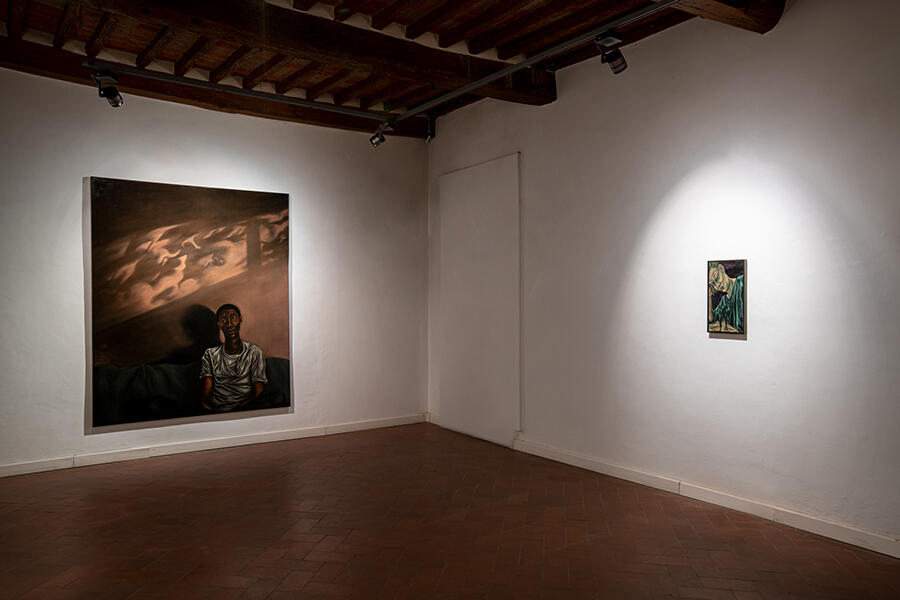Lewis Hammond's Postcards from Purgatory
At Casa Masaccio, San Giovanni, the artist's solo show, 'While We Were Sleeping' leans on religious allegories to depict the nihilist nature of modern anxieties
At Casa Masaccio, San Giovanni, the artist's solo show, 'While We Were Sleeping' leans on religious allegories to depict the nihilist nature of modern anxieties

Entering ‘While We Were Sleeping’ – Lewis Hammond’s solo exhibition at Casa Masaccio, San Giovanni Valdarno – feels like a transgression. It’s first necessary to bypass a heavy wooden door before continuing down an unlit corridor, guided only by a woman’s languid recitation of ‘Death by Water’, the fourth part of T. S. Eliot’s epic poem, ‘The Waste Land’ (1922). We are soon faced by Drowner (2020), a smaller work by the artist’s usual standards, whose desperate subject, as the title makes clear, is sinking below the surface of murky waters. The positioning of this work implies the viewer’s descent, or rather ascent (the rest of the exhibition is installed over the first and second floors of Casa Masaccio), into Hammond’s perditious, painted realm.

Eliot’s words follow us upstairs where the artist’s conflation of the Dantean and the ordinary extend across works of masterfully applied oil on canvas, linen and wooden board. A graduate of London’s Royal Academy of Arts, Hammond’s deft tendency toward tenebrism and frontal perspective complements the pervading, disquieting sensuality of his works. In one such brooding portrait, Chimezie (rising and falling with the current) (2021) – typical of Hammond’s predilection for a muted, earthen palette and glossy patina – a lone man, bearing an obvious resemblance to the artist himself, sits cross-legged in a bare room. His penetrating, bewildered expression suggests a level of anxiety – he seems to be staring out at some ostensible threat – nevertheless his posture remains relaxed, his hands resting in his lap. Whatever he may be facing, he appears to have already resigned himself to it. Though deep contours trace the creases of his white t-shirt, the depiction of the source of light is, disorientingly, refused.
In two other large-scale paintings, Hurricane (2021) and Beached (2021), Hammond extends and abstracts his original suggestion that an unwonted refusal to depict light in a naturalistic sense, when coupled with the hostility of such confrontational perspectives, can generate productive moments of friction. In the first work, a jaundiced-looking woman, lit so that the shadows shaping her face reveal the form of her skull, casts an offensive gaze out from under her brow, while the second painting depicts an oneiric scene, in which another man stares outward with intent as a dolphin bizarrely languishes in the image’s foreground, a sanguine glow emanating from its belly. There is a moral and spatial element to Hammond’s technique for, in the artist’s paintings, light, gesture and lines of sight are wielded not as sources of nourishment, illumination or veracity, but as ominous ambiguities, neither to be trusted nor believed.

Conceived following a residency during which the artist explored the history of Tuscan art, ‘While We Were Sleeping’ culminates as a conjectural depiction of nihilism via the exploitation of present-day anxieties through canonical painterly modes. Hammond prefers to work in a smaller format when considering individual symbols and codes, combining them to make grander allegories of moral transgression. The artist sometimes loans from the Biblical – in Annunciation (a change will come) (2021), painted on a slim wooden panel, a tall ivory lily, typically a symbol of virtue in Christian semiotics, is desecrated by the imposition of a lurking satanic, horned figure – but mostly, as in Hard Food (2021), which depicts a woman in a moment of apparent exorcism (in spite of her vacant expression, her neck juts out at an impossible angle, while her feet are rendered as sore-looking, toeless stumps) the artist lends from his own painterly vocabulary to create a singular vision of a contemporary purgatory.
Lewis Hammond's 'While We Were Sleeping' is on view at Casa Masaccio, San Giovanni Valdarno, until 8 August.
Head image: Lewis Hammond, Drowner, 2020, installation view. Courtesy: the Artist, Casa Masaccio, San Giovanni Valdarno and Arcadia Missa, London; Photography: Ela Bialkowska, OKNO Studio
Thumbnail: Lewis Hammond, Annunciation (a change will come), 2021, installation view. Courtesy: the Artist, Casa Masaccio, San Giovanni Valdarno and Arcadia Missa, London; Photography: Ela Bialkowska, OKNO Studio





















